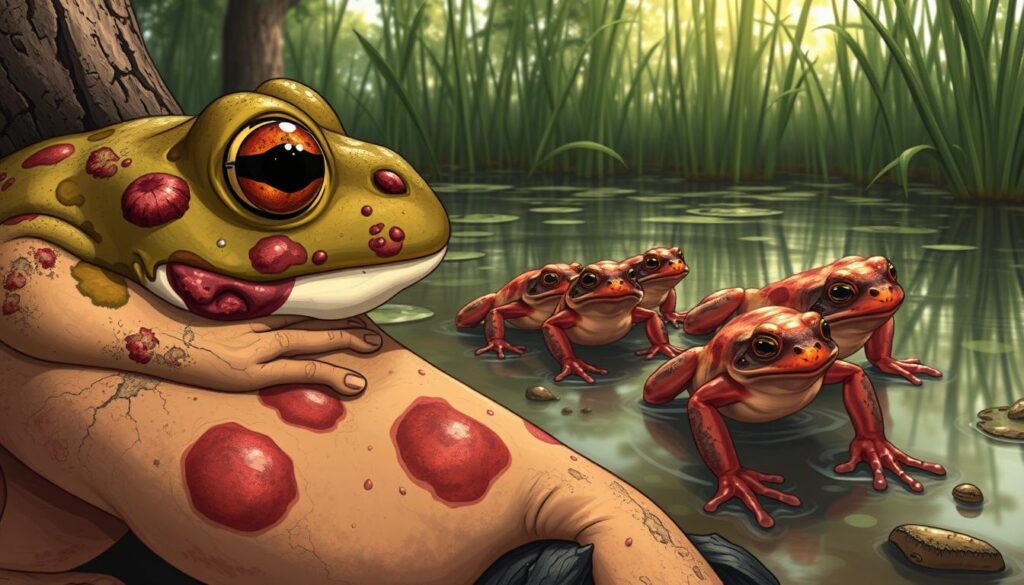Did you know that over 30% of amphibian species are at risk of extinction globally? Frogs, often overlooked, play a critical role in maintaining the health of ecosystems. As indicator species, they signal environmental changes, making their survival a key factor in biodiversity preservation.
These small creatures are more than just part of the food chain. They help control insect populations and serve as both predators and prey, ensuring ecosystems remain balanced. However, their decline is a warning sign of broader environmental issues.
Understanding the interconnectedness of frog survival and ecosystem health is essential. Their sensitivity to pollution, habitat loss, and climate change makes them a vital focus for conservation efforts. Protecting frogs means safeguarding the environment for all species.
Key Takeaways
- Frogs are indicator species, reflecting environmental health.
- Over 30% of amphibian species face extinction risks globally.
- They play a crucial role in maintaining balanced ecosystems.
- Their decline signals broader environmental degradation.
- Conserving frogs helps protect overall biodiversity.
- Learn more about keeping wild frogs and their importance.
Introduction to the Threats Facing Wild Frog Populations
Multiple environmental pressures are contributing to frog declines. These small, vital creatures face five major challenges: habitat destruction, pollution, disease, invasive species, and climate shifts. Each of these factors alone is significant, but together, they create a compounding effect that accelerates population declines.
For example, habitat loss disrupts population connectivity, making it harder for frogs to find mates and resources. Pollution, including pesticides, further weakens their health. Frogs are especially vulnerable due to their permeable skin and aquatic life stages, which make them sensitive to environmental changes.
Organizations like the Rainforest Trust are working to safeguard habitats, providing a model for conservation. Their efforts highlight the importance of protecting ecosystems to ensure the survival of these species. “Conserving frog habitats is not just about saving frogs—it’s about preserving the balance of entire ecosystems,” notes a conservation expert.
Here’s a breakdown of the major threats and their impacts:
| Threat | Impact |
|---|---|
| Habitat Destruction | Disrupts population connectivity and reduces resources. |
| Pollution | Weakens health and increases mortality rates. |
| Disease | Spreads rapidly due to environmental stress. |
| Invasive Species | Competes for resources and preys on native species. |
| Climate Shifts | Alters habitats and breeding cycles. |
Understanding these challenges is the first step toward effective conservation. By addressing these issues, we can help ensure the survival of frogs and the ecosystems they support.
Habitat Loss and Degradation
The rapid expansion of human activities has significantly altered natural landscapes. Urbanization and agriculture are two primary drivers of habitat loss, reshaping ecosystems and displacing countless species. Amphibians, in particular, are highly sensitive to these changes due to their reliance on specific habitats for breeding and survival.
Urbanization and Agriculture
Urban development often leads to the destruction of wetlands and forests, which are critical habitats for amphibians. Similarly, agricultural practices contribute to habitat degradation through deforestation, soil erosion, and the use of harmful chemicals. These activities not only reduce available habitats but also fragment ecosystems, making it harder for species to thrive.

Pollution and Water Contamination
Pollution and water contamination are major threats to amphibian survival. Amphibians absorb toxins through their permeable skin, making them highly susceptible to chemicals like pesticides and industrial pollutants. For example, atrazine, a common pesticide, disrupts hormone systems, leading to reproductive issues and developmental abnormalities.
Water contamination from industrial chemicals and wastewater further exacerbates the problem. These pollutants alter habitats and directly affect the health of amphibians. Sublethal effects, such as reduced stress tolerance and impaired growth, can also weaken populations over time.
Chemicals can synergize with other threats, such as UV-B radiation, amplifying their impacts. For instance, exposure to contaminants can make amphibians more vulnerable to diseases and environmental stressors. “Protecting their environment is crucial for their survival,” emphasizes a conservation expert.
Here’s a summary of the key factors contributing to habitat loss and degradation:
| Factor | Impact |
|---|---|
| Urbanization | Destroys wetlands and forests, fragmenting ecosystems. |
| Agriculture | Leads to deforestation, soil erosion, and chemical pollution. |
| Pollution | Weakens health and disrupts hormone systems. |
| Water Contamination | Alters habitats and increases susceptibility to diseases. |
To learn more about the impact of harmful chemicals on amphibians, visit this detailed guide. Clean water and unpolluted habitats are essential for the survival of these vital species.
Diseases Affecting Frog Populations
Diseases are emerging as a significant challenge for amphibian survival. These illnesses, often exacerbated by environmental stress, are causing dramatic declines in many species. From fungal infections to viral outbreaks, the impact is both widespread and devastating.

Chytridiomycosis: A Global Threat
Chytridiomycosis, caused by the fungus Batrachochytrium dendrobatidis, is one of the most severe diseases affecting amphibians. It leads to hyperkeratosis, a thickening of the skin, which disrupts vital functions like respiration and hydration. Infected individuals often exhibit lethargy, skin sloughing, and convulsions before death.
This disease has caused mass die-offs in over 500 species globally. International trade, particularly in farmed bullfrogs, has played a key role in its spread. For example, over 1 million bullfrogs are imported into the United States annually, increasing the risk of transmission to wild populations.
Ranavirus and Other Pathogens
Ranavirus is another deadly pathogen, particularly lethal to larvae. In some outbreaks, it has killed 100% of infected individuals. This virus spreads through contaminated water and equipment, making it difficult to control. Degraded habitats further increase the risk of outbreaks, as stressed populations are more vulnerable.
The Sonora tiger salamander is a stark example. Its populations have crashed due to iridovirus, a relative of Ranavirus. These episodic die-offs highlight the unpredictable nature of such diseases. Mycoplasma, a bacterium causing respiratory issues in desert tortoises, also poses a threat to amphibians.
Controlling waterborne pathogens remains a significant challenge. Effective surveillance and management protocols are essential to mitigate these risks. “Protecting amphibians from diseases requires a multi-faceted approach,” notes a conservation expert. Learn more about chytrid infection and its impact.
| Disease | Impact |
|---|---|
| Chytridiomycosis | Causes skin thickening, leading to death. |
| Ranavirus | Kills larvae and spreads through water. |
| Iridovirus | Leads to population crashes in species like the Sonora tiger salamander. |
| Mycoplasma | Causes respiratory issues in amphibians. |
Invasive Species and Climate Change
Amphibians face growing challenges from invasive species and shifting climates. These factors disrupt ecosystems, making it harder for native species to thrive. Invasive species compete for resources and prey on amphibians, while climate change alters habitats and breeding cycles.

Invasive Species: Predators and Competitors
Invasive species, such as bullfrogs and fish, often outcompete native amphibians for food and space. They also prey on eggs and tadpoles, reducing population numbers. For example, bullfrogs, introduced for farming, have spread widely, threatening native species.
These invaders thrive in degraded habitats, where native species are already stressed. Their presence further weakens ecosystems, making recovery difficult. Conservation efforts must focus on controlling invasive species to protect native amphibians.
Climate Change and Its Effects
Climate change is reshaping habitats and altering survival conditions. In the Western U.S., temperatures have risen by 0.8°C since the 1950s. This warming disrupts breeding cycles and can skew sex ratios in some species.
Droughts, another consequence of climate change, reduce the success of metamorphosis in pond-breeding frogs. Tadpoles often face overcrowding and must undergo early metamorphosis, which weakens their chances of survival. Increased wildfires, linked to climate change, also destroy habitats, such as the tinajas in SAGU.
Rattlesnakes, for instance, have adapted by harvesting rainwater during droughts. However, amphibians are less adaptable, making them more vulnerable. Future projections suggest temperature rises of 2-5°C, which could further threaten their survival.
| Factor | Impact |
|---|---|
| Invasive Species | Competes for resources and preys on native species. |
| Temperature Rise | Disrupts breeding cycles and skews sex ratios. |
| Droughts | Reduces metamorphosis success and causes overcrowding. |
| Wildfires | Destroys critical habitats. |
Conclusion: The Importance of Conservation Efforts
Collaborative solutions are essential for effective conservation. Protecting habitats and restoring ecosystems have already shown success. For example, the Rainforest Trust’s projects in Panama and Madagascar have safeguarded over 100 species.
Reducing pesticide use and safeguarding wetlands are critical steps. Community education also plays a vital role in reducing human-wildlife conflicts. Captive breeding programs, like those for the Sonora tiger salamander, demonstrate how targeted efforts can restore populations.
Policy support and funding are needed to address data gaps and disease challenges. By working together, we can ensure the survival of these vital species and the ecosystems they support. Every action counts in preserving our planet’s biodiversity.
FAQ
What are the main causes of habitat loss for frogs?
How does pollution impact frog survival?
What is chytridiomycosis, and why is it dangerous?
How do invasive species affect native frog populations?
What role does climate change play in frog declines?
Why are frogs considered indicator species?
What can be done to protect frog populations?

I’m Lena Adams—a product of an unconventional upbringing in the African wilderness. My father, a daring explorer of African wildlife, sparked my fascination with reptiles, a passion that intertwined with the tragic loss of my mother during an expedition, leaving an indelible mark on my life. Driven to understand the creatures that captivated my parents, I embarked on my journey, sharing insights about reptiles, frogs, and lizards on my website. Through my explorations and conservation efforts, I honour my family’s legacy while seeking connections—to the creatures, nature, and the mother whose presence I yearn to understand.
